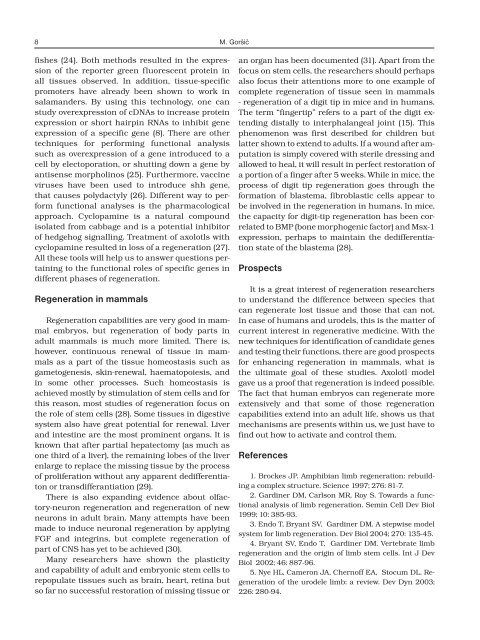Slov Vet Res 2007; 44 (1/2) - Slovenian veterinary research
Slov Vet Res 2007; 44 (1/2) - Slovenian veterinary research
Slov Vet Res 2007; 44 (1/2) - Slovenian veterinary research
You also want an ePaper? Increase the reach of your titles
YUMPU automatically turns print PDFs into web optimized ePapers that Google loves.
8<br />
M. Goršič<br />
fishes (24). Both methods resulted in the expression<br />
of the reporter green fluorescent protein in<br />
all tissues observed. In addition, tissue-specific<br />
promoters have already been shown to work in<br />
salamanders. By using this technology, one can<br />
study overexpression of cDNAs to increase protein<br />
expression or short hairpin RNAs to inhibit gene<br />
expression of a specific gene (8). There are other<br />
techniques for performing functional analysis<br />
such as overexpression of a gene introduced to a<br />
cell by electoporation, or shutting down a gene by<br />
antisense morpholinos (25). Furthermore, vaccine<br />
viruses have been used to introduce shh gene,<br />
that causes polydactyly (26). Different way to perform<br />
functional analyses is the pharmacological<br />
approach. Cyclopamine is a natural compound<br />
isolated from cabbage and is a potential inhibitor<br />
of hedgehog signalling. Treatment of axolotls with<br />
cyclopamine resulted in loss of a regeneration (27).<br />
All these tools will help us to answer questions pertaining<br />
to the functional roles of specific genes in<br />
different phases of regeneration.<br />
Regeneration in mammals<br />
Regeneration capabilities are very good in mammal<br />
embryos, but regeneration of body parts in<br />
adult mammals is much more limited. There is,<br />
however, continuous renewal of tissue in mammals<br />
as a part of the tissue homeostasis such as<br />
gametogenesis, skin-renewal, haematopoiesis, and<br />
in some other processes. Such homeostasis is<br />
achieved mostly by stimulation of stem cells and for<br />
this reason, most studies of regeneration focus on<br />
the role of stem cells (28). Some tissues in digestive<br />
system also have great potential for renewal. Liver<br />
and intestine are the most prominent organs. It is<br />
known that after partial hepatectomy (as much as<br />
one third of a liver), the remaining lobes of the liver<br />
enlarge to replace the missing tissue by the process<br />
of proliferation without any apparent dedifferentiaton<br />
or transdifferantiation (29).<br />
There is also expanding evidence about olfactory-neuron<br />
regeneration and regeneration of new<br />
neurons in adult brain. Many attempts have been<br />
made to induce neuronal regeneration by applying<br />
FGF and integrins, but complete regeneration of<br />
part of CNS has yet to be achieved (30).<br />
Many <strong>research</strong>ers have shown the plasticity<br />
and capability of adult and embryonic stem cells to<br />
repopulate tissues such as brain, heart, retina but<br />
so far no successful restoration of missing tissue or<br />
an organ has been documented (31). Apart from the<br />
focus on stem cells, the <strong>research</strong>ers should perhaps<br />
also focus their attentions more to one example of<br />
complete regeneration of tissue seen in mammals<br />
- regeneration of a digit tip in mice and in humans.<br />
The term “fingertip” refers to a part of the digit extending<br />
distally to interphalangeal joint (15). This<br />
phenomenon was first described for children but<br />
latter shown to extend to adults. If a wound after amputation<br />
is simply covered with sterile dressing and<br />
allowed to heal, it will result in perfect restoration of<br />
a portion of a finger after 5 weeks. While in mice, the<br />
process of digit tip regeneration goes through the<br />
formation of blastema, fibroblastic cells appear to<br />
be involved in the regeneration in humans. In mice,<br />
the capacity for digit-tip regeneration has been correlated<br />
to BMP (bone morphogenic factor) and Msx-1<br />
expression, perhaps to maintain the dedifferentiation<br />
state of the blastema (28).<br />
Prospects<br />
It is a great interest of regeneration <strong>research</strong>ers<br />
to understand the difference between species that<br />
can regenerate lost tissue and those that can not.<br />
In case of humans and urodels, this is the matter of<br />
current interest in regenerative medicine. With the<br />
new techniques for identification of candidate genes<br />
and testing their functions, there are good prospects<br />
for enhancing regeneration in mammals, what is<br />
the ultimate goal of these studies. Axolotl model<br />
gave us a proof that regeneration is indeed possible.<br />
The fact that human embryos can regenerate more<br />
extensively and that some of those regeneration<br />
capabilities extend into an adult life, shows us that<br />
mechanisms are presents within us, we just have to<br />
find out how to activate and control them.<br />
References<br />
1. Brockes JP. Amphibian limb regeneration: rebuilding<br />
a complex structure. Science 1997; 276: 81-7.<br />
2. Gardiner DM, Carlson MR, Roy S. Towards a functional<br />
analysis of limb regeneration. Semin Cell Dev Biol<br />
1999; 10: 385-93.<br />
3. Endo T, Bryant SV, Gardiner DM. A stepwise model<br />
system for limb regeneration. Dev Biol 2004; 270: 135-45.<br />
4. Bryant SV, Endo T, Gardiner DM. Vertebrate limb<br />
regeneration and the origin of limb stem cells. Int J Dev<br />
Biol 2002; 46: 887-96.<br />
5. Nye HL, Cameron JA, Chernoff EA, Stocum DL. Regeneration<br />
of the urodele limb: a review. Dev Dyn 2003;<br />
226: 280-94.
















